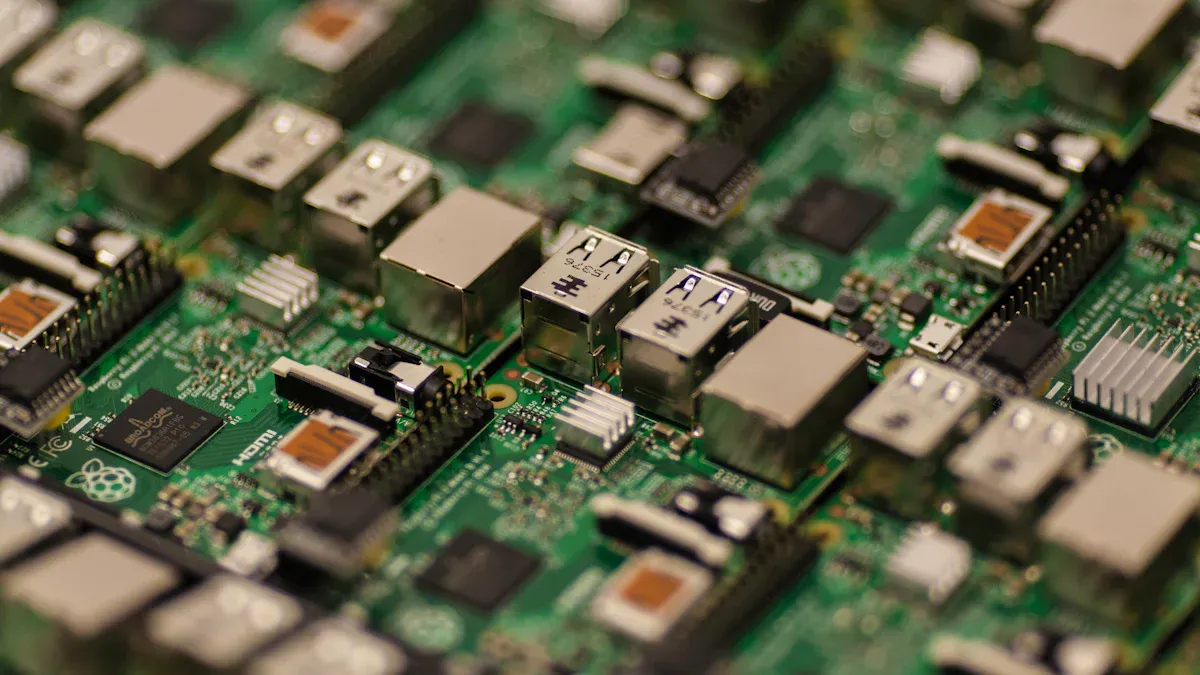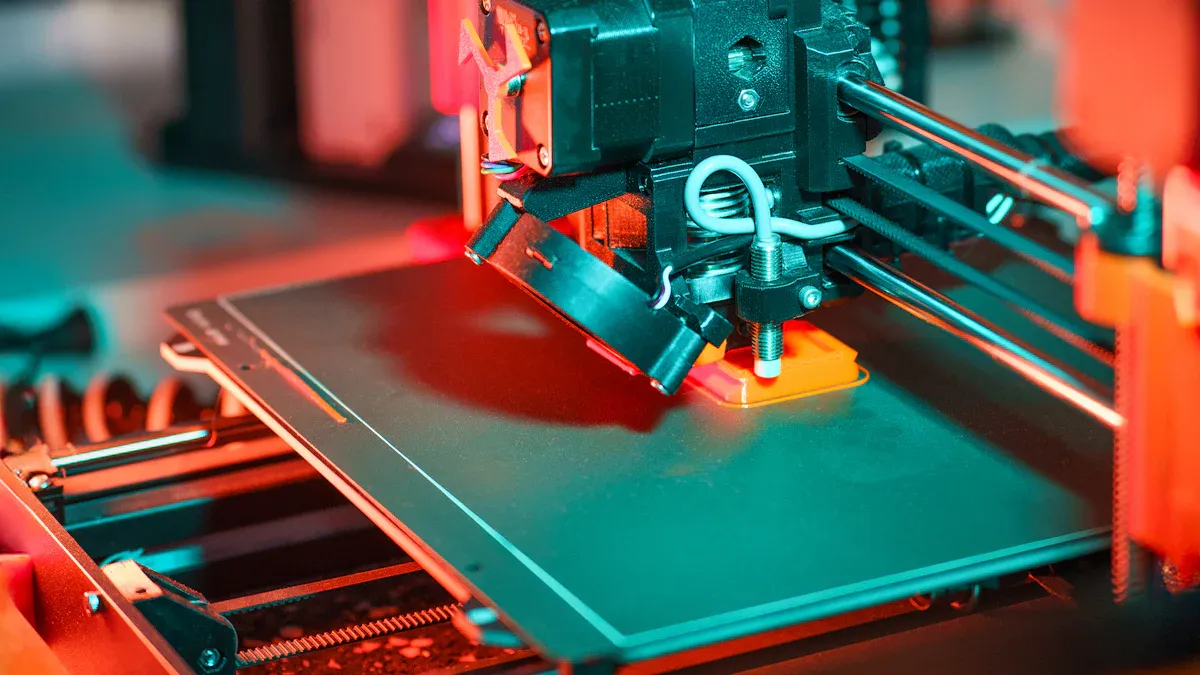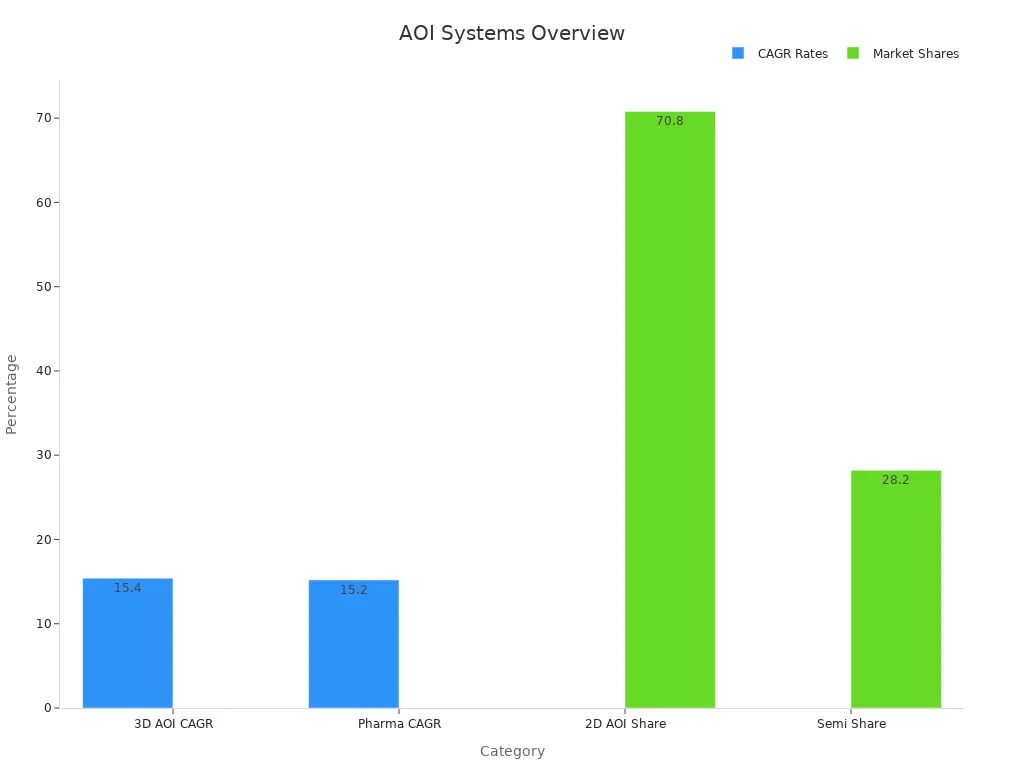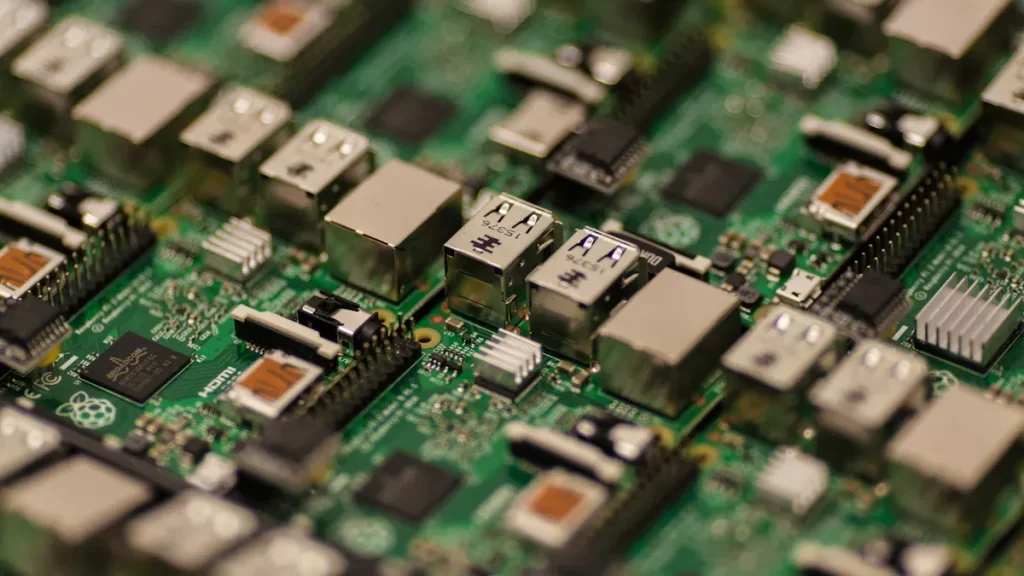
Automated optical inspection for PCBA (AOI) uses machines to check circuit boards. It looks for problems in PCBs and PCB assemblies (PCBAs). AOI employs special cameras and software to identify mistakes, including soldering issues, missing parts, or components that are out of place. Unlike human inspectors, AOI operates faster and with greater accuracy.
AOI systems are excellent for producing many boards quickly. They detect errors more effectively than people, who can overlook details. As PCBs become more complex, automated optical inspection for PCBA has become increasingly vital. It helps maintain high quality and ensures that electronics function properly.
Key Takeaways
Automated Optical Inspection (AOI) uses machines to find problems in circuit boards. This helps make electronics reliable and high quality.
AOI systems work faster and better than people. They are important for today’s complicated PCB designs.
Using AOI can save money by spotting mistakes early. It also cuts repair costs and makes production more efficient.
2D and 3D AOI systems each have benefits. 2D systems are cheaper for simple boards, while 3D systems are more accurate for complex ones.
Mixing AOI with other checks, like X-ray, finds more defects. This ensures better quality control in making PCBs.
What is Automated Optical Inspection?
Definition and Purpose
Automated optical inspection, or AOI, uses machines to check PCBs and PCBAs for problems. It relies on smart cameras and software to find issues like soldering mistakes, missing parts, or misplaced components. This process ensures every board meets quality rules before moving forward in production.
Why is AOI so important? Modern electronics are more complicated than ever. Human inspections often miss small errors because of this complexity. AOI solves this by working faster and spotting mistakes more accurately. It helps keep electronic devices reliable, which is crucial for industries like cars, healthcare, and gadgets.
Studies show how important AOI is for PCB manufacturing:
It checks devices under test (DUT) for problems like solder shorts, open circuits, and misplaced parts.
Machine vision cameras and software ensure precise inspections.
The AOI equipment market is growing fast due to the need for better inspection tools.
By using AOI, manufacturers can produce high-quality products and avoid sending faulty items to customers.
Key Features of AOI Technology
AOI technology has many features that make it essential today. Here are some of its main abilities:
Finding Multiple Defects: AOI can spot many issues at once, like soldering errors, missing pieces, or alignment problems. This saves time and boosts efficiency.
Extreme Accuracy: AOI systems handle complex PCB designs better than humans. They are great for boards with tiny parts.
Adjustable Settings: Operators can change inspection settings to fit different designs, making AOI flexible for various projects.
Saving Money: Catching problems early with AOI lowers repair costs. Fixing mistakes during production is cheaper than fixing them later.
Final Quality Check: AOI is mainly used after production to ensure all boards meet standards before shipping.
Data supports the rise of AOI. The electronics industry is growing over 6% yearly through 2025, increasing the need for AOI. Companies using AI-powered AOI report up to 30% better efficiency than older methods. These features make AOI a must-have for staying competitive in the fast-moving electronics world.
How Automated Optical Inspection Works

Image Acquisition Process
The first step in AOI is capturing images of the PCB. The system is programmed with rules using sample boards or CAD data. This helps the machine know what to check during inspection. Cameras or laser scanners take clear pictures of the board from different angles. These pictures are used to find problems.
Bright lights shine on the circuit board during this step. The lighting makes parts and solder joints easier to see. This helps the system spot mistakes. Using advanced cameras and good lighting ensures clear images, even for tricky designs.
Step | Description |
|---|---|
Setup and Programming | The AOI system is set up with inspection rules using sample boards or CAD data. |
Image Capture | Cameras or laser scanners take detailed pictures of the board from different angles. |
Image Analysis | Software compares the pictures to the rules to find mistakes. |
Image Processing Techniques
After capturing images, the AOI system analyzes them using smart software. It compares the pictures to stored data or standards. The system looks for differences, like missing parts or soldering mistakes.
New image processing tools have made defect detection better. For example, deep learning models can study complex shapes and tiny flaws. These tools can even find hidden problems, like tiny holes inside parts. By combining high-tech cameras and smart software, AOI systems are now more accurate and reliable.
Defect Detection Mechanisms
AOI systems are built to find many types of problems. These include soldering mistakes, missing parts, and alignment issues. The system compares the pictures to the programmed rules. If it finds something wrong, it flags it for review.
Different methods have different strengths. For example:
Pan et al.’s method is very precise but needs special lighting.
Ding et al.’s approach is fast and accurate, great for quick checks.
Advanced methods like STMask R-CNN are super accurate but use a lot of computer power.
Method | Detection Accuracy | Processing Time | Notes |
|---|---|---|---|
Pan et al. | Up to 6 µm | N/A | Very precise but needs special lighting |
Ding et al. | 97.5% | 0.636 seconds | Fast and accurate for quick checks |
Yang et al. (ISE-YOLO) | mAP 94.23%, F1 90.60% | N/A | Good results but uses more computer power |
Tang et al. (STMask R-CNN) | 98.2% precision, 97.7% recall, mAP 98.1% | N/A | Very accurate but hard to use for quick checks |
These systems catch problems early, saving money and improving product quality.
Role of Automated Optical Inspection for PCBA
Quality Control in PCBA
Automated optical inspection (AOI) helps keep circuit boards high-quality. It finds problems early, like soldering mistakes or missing parts. AOI systems are very accurate and ensure boards meet strict rules.
In one factory, charts tracked soldering quality in real-time. This helped spot issues, like a broken heater, quickly. Fixing it improved the number of good boards made. AI-powered AOI systems are even better. While people find 80% of problems, AI finds up to 99%. This makes results more reliable.
The benefits of AOI for quality control are clear:
Benefit | Value |
|---|---|
Defect escape rate | Cut by 85% |
First-pass yield | Rose from 92% to 98% |
Rework costs | Lowered by 60% |
Traceability of defects | 100% traceable |
ROI | Gained in 8 months |
These gains show how AOI improves quality and lowers risks.
Cost Reduction Benefits
AOI saves money by reducing waste and fixing fewer errors. Companies using manual checks often have more defects and higher costs. For example, one company had a 5% defect rate with manual checks. Another company used AOI and cut defects to 1%, saving money and improving its reputation.
By catching mistakes early, AOI stops costly errors later. This reduces repair costs and keeps customers happy. While AOI systems cost more at first, they save money over time and make products more reliable.
Enhancing Production Efficiency
AOI makes production faster and smoother by improving inspections. It reduces waste, cuts costs, and increases the number of good boards made. During production, AOI collects data to check assembly lines in real-time. This ensures steady quality and quicker results.
AOI systems work fast and find problems early. This avoids delays and keeps production running well. Companies using AOI report less waste and better productivity. These systems are key for staying competitive in electronics manufacturing.
Types of Automated Optical Inspection Systems
2D AOI Systems
2D AOI systems are older tools for checking PCBs. They use cameras to take pictures of the board’s surface. These systems find problems like missing parts or soldering mistakes. But they have trouble with curved or tricky surfaces.
Some facts about 2D AOI systems:
They make up 70.8% of the market in 2024.
They are cheaper and work well for simple PCB designs.
They often flag too many errors, slowing inspections.
Note: 2D AOI systems can’t measure defects, which makes fixing issues harder.
3D AOI Systems
3D AOI systems are newer and more advanced. They use lasers or special lights to create 3D images of PCBs. These systems measure height, volume, and shape to find problems on complex surfaces.
Benefits of 3D AOI systems include:
Ability to handle new types of defects.
Works well for large-scale production.
The 3D AOI market is growing fast, with a CAGR of 15.4% from 2024 to 2034. Industries like biotech and semiconductors need these systems for precise checks.

Advantages and Limitations of Each System
Both 2D and 3D AOI systems have pros and cons. Here’s a comparison to explain their differences:
AOI Systems | Advantages | Limitations |
|---|---|---|
2D AOI Systems | Affordable, easy to find, good for simple boards | Flags too many errors, struggles with curved surfaces, can’t measure defects |
3D AOI Systems | Accurate for complex boards, flexible, good for big production | Costs more, needs strong computers |
Tip: Use 3D AOI systems for detailed PCB designs. For basic boards, 2D AOI systems are still useful.
Knowing these systems helps you pick the best one for your needs. Whether you want to save money or focus on accuracy, both systems help keep PCBs high-quality.
Defect Detection in PCBs

Soldering Defects
Soldering problems are very common in circuit boards. These happen when solder connections are weak or fail. Automated Optical Inspection (AOI) systems help find these issues. They use cameras and lights to check solder joints. Problems like solder bridging, incomplete soldering, or cold joints are detected easily.
Other tools, like Automatic Laser Test (ALT) and X-ray systems, also help. ALT checks the height and shape of solder joints. X-rays show hidden problems like cracks or voids. These methods ensure solder connections are strong and meet standards.
Inspection Method | Key Features |
|---|---|
AOI | Finds solder bridging, incomplete soldering, and joint issues. |
ALT | Measures solder joint height and alignment. |
X-ray Systems | Spots hidden defects like cracks and voids. |
Component Defects
Component problems happen when parts are damaged, missing, or misplaced. These issues can stop the board from working. AOI systems are great at spotting these problems. They compare the board to a pre-set standard. Missing parts, wrong orientations, or misaligned pieces are quickly found.
For example, a study used 16,000 training images and 1,600 test images. It found common issues like scratches, copper exposure, and coating problems. Fixing these early saves money and ensures the board works well.
Other Common Defects
PCBs can also have short circuits, open circuits, or surface problems. Short circuits happen when paths connect by mistake. Open circuits occur when connections are broken. Tools like optical microscopes and scanning electron microscopes find these problems.
These tools also detect hidden issues like voids or delamination. Such problems can weaken the board’s performance. Fixing these during inspections keeps boards high-quality and reliable.
Comparing AOI with Other Inspection Methods
AOI vs. Automated X-ray Inspection (AXI)
AOI and AXI have different strengths. AOI checks surface problems like solder issues or missing parts. AXI looks inside boards for hidden problems like cracks or voids.
Feature | Automated Optical Inspection (AOI) | Automated X-ray Inspection (AXI) |
|---|---|---|
Inspection Capability | Surface-level only | Internal structures and hidden defects |
Throughput | High | Slower due to complexity |
Cost | Lower | Higher |
Detection of Small Defects | Limited to visible defects | Finds micro-cracks and voids |
False Rejects and Escapes | Possible | Less likely with thorough checks |
AOI is faster and cheaper, great for large production. But it misses hidden flaws. AXI finds deeper issues but costs more and works slower. Using both together ensures better quality checks for complex boards.
AOI vs. Manual Inspection
Manual inspection depends on people, so results can vary. AOI uses machines to find small mistakes humans might miss.
Metric | Automated Optical Inspection (AOI) | Manual Inspection |
|---|---|---|
Accuracy | High, finds tiny mistakes | Prone to human error |
Speed | Fast, scans quickly | Slower, takes more time |
Consistency | Always reliable | Depends on the inspector |
Cost-effectiveness | Saves money over time | Costs more for labor |
Human Error Reduction | Much lower | Higher chance of mistakes |
AOI inspects many boards quickly and accurately. Manual checks are slower and less reliable. Switching to AOI saves money and boosts efficiency.
AOI vs. Other Testing Methods
AOI finds surface problems early without powering up the board. This avoids damage but doesn’t catch every issue.
Method | Applicability | Statistical Validity | Extent of Data Analysis | Improvement Identification |
|---|---|---|---|---|
Pass-Fail | Used in manual checks | Not valid | Low to moderate | Limited by inspector skills |
Knapp | Works with automated checks | Statistically valid | Moderate | Helps train inspectors |
3A Method | Fits manual and automated checks | Statistically valid | Detailed | Improves training and processes |
For the best results, combine AOI with other methods like flying probe testing. This ensures thorough checks and fewer missed defects.
Automated optical inspection (AOI) helps keep PCB assemblies reliable. It finds and fixes problems early to save money. If defects are missed, costs can rise from $0.40 to $45. AOI reduces mistakes made by people, making production more consistent.
Using AOI also improves how electronics are made. It cuts waste, speeds up checks, and ensures only good boards are used. AOI helps balance costs and efficiency, making it essential for modern PCB production.
FAQ
1. What does Automated Optical Inspection (AOI) do?
AOI checks PCBs and PCBAs for problems like soldering mistakes or missing parts. It ensures high-quality production and prevents expensive errors.
2. How is AOI different from manual inspection?
AOI uses machines to inspect boards faster and more accurately. Manual inspection depends on people, which can lead to slower checks and more mistakes.
3. Can AOI find every defect?
AOI is great at spotting surface problems like soldering errors or missing pieces. But it can’t find hidden issues like cracks. Using AOI with X-ray inspection helps catch all defects.
4. Is AOI good for small production runs?
Yes, AOI works well for both small and large productions. It keeps quality consistent and reduces the need for manual work, making it useful for any production size.
5. Which industries use AOI the most?
Industries like cars, healthcare, and electronics depend on AOI. These fields need reliable PCBs for important uses, so AOI helps meet their high standards.
Tip: Choose AOI systems that fit your production size and budget.
See Also
Ensuring Quality Control Throughout The PCBA Manufacturing Process
The Role Of IPC-A-610 In Guaranteeing PCBA Quality
Exploring AI’s Impact On PCBA In Today’s Electronics
RSJPCBA’s Commitment To Quality In PCB And PCBA
Achieving High-Quality Outcomes Through PCBA Manufacturing Mastery





